The history of the Giulia began with a mixture of needs. The commercial success of the 1900, whose history we told you about in previous instalments, encouraged the company to launch the Giulietta in 1955. It was a compact sedan, four metres long, with a 1.5-litre longitudinal front engine and 53 horsepower.
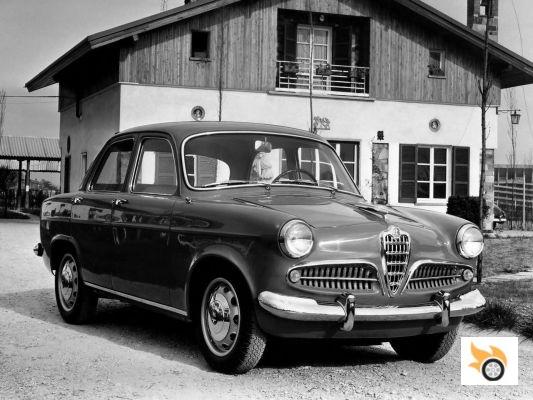
Giulietta
Placed in what today would be the C-segment of the market, the Giulietta was a commercial success, with more than 130,000 units produced of the sedan versions (coupes and derivatives aside) in its commercial run until 1965.
As we told you the other day, the evolution of the 1900 would lead Alfa Romeo to launch first the 2000 and then the 2600, which placed these models in the E segment by right, while what would become the D segment remained without a specific model. That is why in 1962 it was decided to launch a product, the Giulia, which would take the place of the missing 1900, being somewhat bigger, more expensive and more powerful than the Giulietta, but without reaching the size of the 2600.
The project started with a technical approach quite similar to that seen in the Giulietta and the 1900. To begin with, the same inline four with twin overhead camshafts, steel block and aluminium cylinder head used in the Giulietta was used, but its displacement was increased to 1,570 cubic centimetres. This made 95 hp available at 6,000 rpm and around 130 Nm of torque at 4,400 rpm.
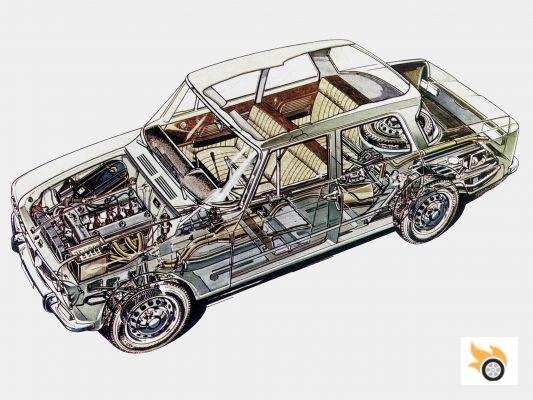
The engine was positioned longitudinally, behind the front axle, associated with a five-speed manual gearbox, whose control was located on the steering column at first, although complaints from customers and specialized media testers made first to offer an optional change in the floor of the vehicle, which would eventually become standard equipment.
The bodywork, designed by Giuseppe Scarnati, would be a revolution. The reality is that the aesthetic concepts of the car would be extensively tested previously in the Tipo 103 project, a model that would never go into series production, but which sought to create a small 3.6-metre saloon with a front-transverse engine and front-wheel drive, in an attempt to answer the British Mini.
That Tipo 103 would serve as the aesthetic inspiration for the Renault 8 (at the time Renault and Alfa Romeo had joint projects), but it would also be the basis for Scarnati to develop the Giulia's theme. In the Giulia, special emphasis was placed on creating a car with its own character and personality, and with carefully designed aerodynamics.
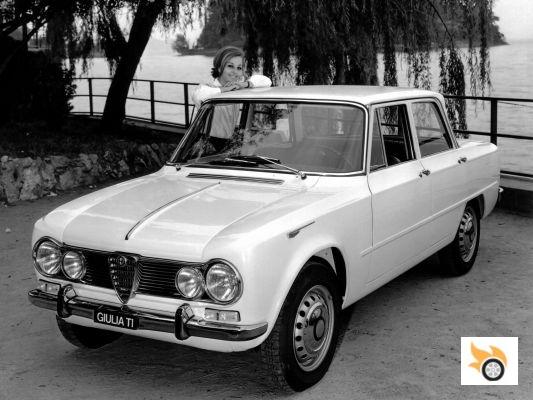
In fact, the Giulia would achieve a record Cx of only 0.34 at the time. The front end would abandon the elaborate and organic tri-lobe in favour of a much straighter horizontal grille and double headlights of differentiated diameter, with Alfa's inverted central triangle presiding over the styling.
The side line was marked by the rear wheels integrated into a fin that visually "bit" them and a tail cut in reverse diagonal to improve the aerodynamic performance of the car. At 4.13 metres long, it was 13 centimetres longer than the Giulietta, but 27 centimetres shorter than the 1900 that preceded it.
In terms of chassis and suspension, the steel monocoque body incorporated for the first time a programmable crumple zone design in the event of an accident. The front suspension was double wishbone superimposed, while the rear had a rigid axle guided by two longitudinal arms. The joints no longer needed periodic lubrication.
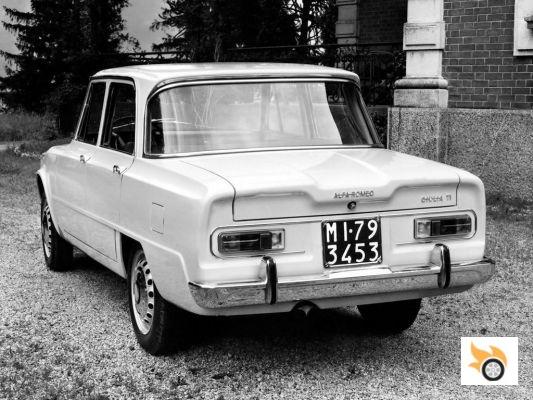
The brakes were disc brakes on the front axle while the rear had drums in the first instance, something that would eventually be replaced by disc brakes on all four wheels after the first 22,000 units produced.
As I told you at the beginning, the presentation took place in 1962, specifically at the Monza racetrack, where the T.I. (Turismo Internacional) variant was launched with a sporty spirit. After that, in 1963, and with the quadrifoglio painted on its front wings, the T.I. Super was launched as a special homologation model in order to start the saloon's sporty plans.
The Super received a second twin carburettor to allow the engine to reach 112 hp at 6,500 rpm and almost 140 Nm of maximum torque at 4,200 rpm. Weight was reduced to 910 kilos (the normal T.I. weighed 1,000), thanks to the elimination of a lot of "superfluous" elements and the use of polycarbonate windows in the rear window and the side windows of the rear doors.
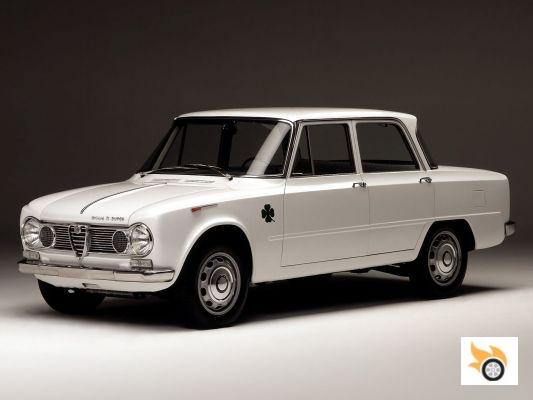
Giulia T.I. Super
The brake discs were incorporated into the rear axle, and the car was marketed in a short series of 501 copies, one more than necessary to homologate the car.
In 1964 the "economic" version of the Giulia arrived, with the launch of the Giulia 1300, with the same engine that had been used until then in the Giulietta T.I. (which disappeared from the market that year), a 1,290 cubic centimetre engine with 78 horsepower at 6,000 rpm and 110 Nm of maximum torque at 4,500 rpm. The front lost the twin headlights to settle for only two, but the four brake discs were retained.
The final step in the Giulia's career came in 1965 with the launch of the Giulia Super. This combined extra power thanks to the use of two twin carburettors, with 100 hp at 5,500 rpm and almost 140 Nm of maximum torque from just 2,900 revs, with a top speed of 175 km/h, a weight of 990 kilograms and great improvements in materials, finishes and interior climate control.
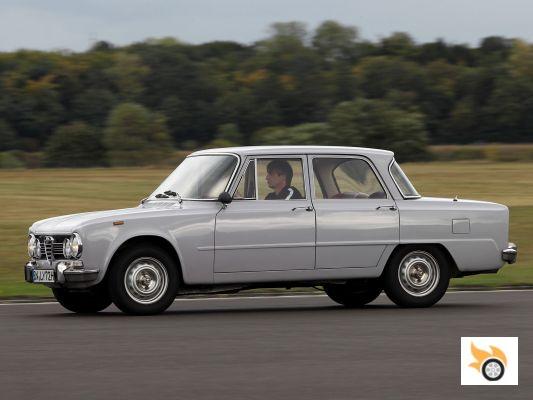
Giulia Super
With almost 125,000 units of the Giulia Super produced, it was this variant that achieved the success Alfa Romeo expected from its saloon.
In 1966, just one year later, the Giulia T.I. 1300 was launched, more powerful than the conventional 1300, with 82 hp, to complete the range. From then on and until the model ceased production, Alfa Romeo updated the product every year with small improvements.
Thus, in 1967 the car received a deep restyling, with a new grille, new sound insulators that reduced the noise in the passenger compartment by 60%, two-speed windscreen wipers, and improvements in power delivery in all engines.
The biggest change of all came in the last period of the product's commercial life, between 1974 and 1977, with the marketing of the Nuova Super, which softened the radii of the body folds and included a new dashboard and new seats among other modifications.
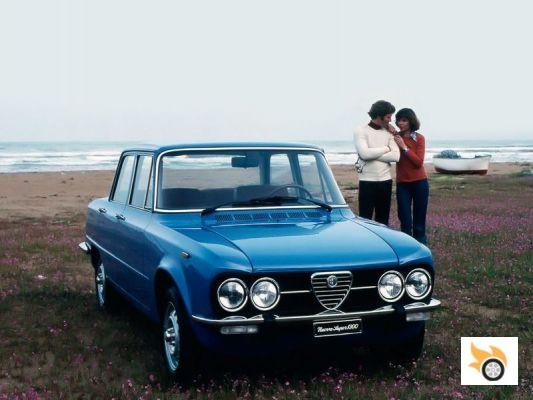
Nuova Super
All in all, throughout its full commercial life, from 1962 to 1978, about one million Giulias, among all its variants, were marketed globally, becoming one of the most successful models of the company, and consolidating the basis of how a "premium and sporty" Alfa Romeo sedan was to be.
The succession of the Giulia would have split paths. On the one hand, the Alfa Romeo 1750 would be born first, closely related to the Giulia, which in turn would give birth to the Alfetta, as segment E, while at the other end, the Giulietta of 1977 would be in charge of covering the segment that today would be the D segment.
But the history of both is left for two future installments. In the meantime I leave you this Giulia resto-mod that appeared months ago in Petrolicious.
The return of Alfa Romeo: from the 1900 to the Giulia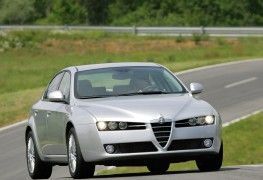
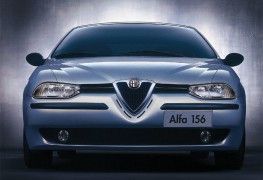
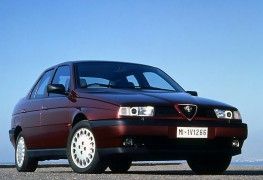
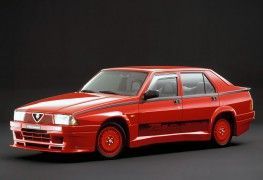
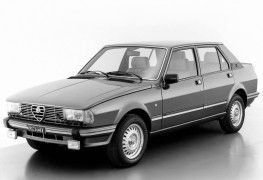 Giulietta (1977 – 1985)">
Giulietta (1977 – 1985)">

























